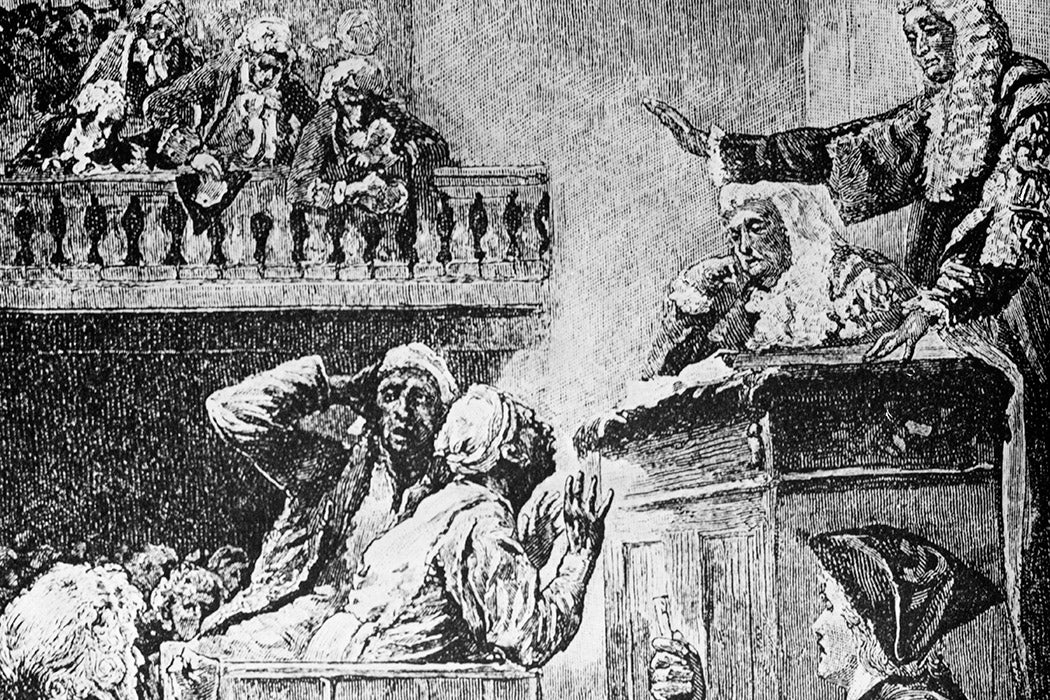There were fires sweeping across New York City in the spring and summer of 1741. The first was at Fort George in Manhattan.The fire “supposedly began on the roof of the governor’s house and spread from there,” writes historian Thomas J. Davis, “consuming, in approximately an hour and a quarter, much of Fort George, the official seat of royal government.”
The fires were a mystery with no answer in sight. That is, until the tenth fire. Someone reported they’d seen a person—reportedly an enslaved man named Quack (some sources name him as Quaco)—leaving the scene of that fire. A white woman also claimed that she’d heard him saying, “Fire, Fire, Scorch, Scorch, a little, damn it, by-and-by.”
And that’s when the rumors began that this was the beginning of a nefarious plot. As historian Andy Doolen writes, the city concluded that “the puzzling fires were really opening salvos in a massive slave insurrection” and quickly leapt into action. According to Davis, officials heard that “many of the more than 2,000 slaves, and some other persons, had conspired to burn down the town and to murder most of its approximately 9,000 white inhabitants.”
According to Doolen, the state was also quick to punish the alleged conspirators. Thirty slaves and four white ringleaders were executed, and the state also “publicly flogged 50 slaves, and transported over 70 more to the Caribbean slave markets, never to return.”
But the question still lingers—was the plot even real?
This was a pivotal time in the city’s history. Historian Richard E. Bond explains the city was becoming a booming metropolis. Because of trans-Atlantic and intercolonial trade, shipping and related labor was a huge industry. By 1741, the population was around 11,000, and “an additional twenty thousand men and women lived within the agricultural hinterland that supplemented this burgeoning town.”

There was also an active slave trade that stretched throughout the city and into the Hudson River Valley, Long Island, and New Jersey. Once purchased and in their new homes, enslaved New Yorkers were required to travel the city in the possession of a travel pass from their enslavers. With these passes (and occasionally without), they were able to run errands, see friends, work, and attend religious services. All of this meant that seeing Black people on the streets at any time of day wasn’t unusual.
White New Yorkers were already suspicious of Black people and their movements, and the fires, coupled with Quack’s alleged statement, deepened that suspicion. As Davis describes, the blazes had white people in near hysteria at the thought of a plot: “it was causing intense worry.” Everyone was viewed as a potential threat. The fires had been coupled with a series of thefts, and fingers immediately pointed to Black people. This led to raids on Black homes in search of not only the stolen goods, but strangers and others who seemed not to belong. The results didn’t matter, as Bond writes, because “New Yorkers were convinced that slaves were constantly violating the law even if they were never caught.”
This belief partly came from the movement that slaves were allowed in the city. This, it was argued, gave Black people (and sympathetic white people) ample opportunity to gather and plot. Quack, for example, often visited Fort George because his wife worked there. He was also thought to be among the more than forty Black men who met at a local tavern to plan the revolt. And it was talk at that tavern, Bond explains, that wrapped “an unnamed number of other slaves in a conspiracy to ‘burn the whole town,’ to overthrow white authorities, and to create a new society.”
Weekly Newsletter
Quack and one other man ultimately confessed to the plot, but as Bond points out, that confession came “while tied to a stake, ‘surrounded with Piles of Wood ready for setting fire to’ and a crowd of onlookers calling for the two [B]lack men’s blood.” Other Black witnesses were also likely coerced into confessions in exchange for lighter sentences. And, as Doolen notes,
when the jails became overcrowded and the city’s slaves learned of their precarious situation—one incriminating statement away from execution—Governor Clarke announced a proclamation offering pardon and transportation to those who confessed to the conspiracy.
Others, rather than face execution, agreed to be sent to West Indian plantations and slave markets, forever separated from their loved ones.
The death and violence at the hands of the state resulted in 156 slaves and free blacks were committed, seventeen executed by hanging, thirteen burnt at the stake, and seventy deported to West Indian slave markets and plantation,” Doolen writes. And as researchers have written over the years, little evidence that there was a conspiracy (beyond Black people’s overall resistance against the institution). Historian Jill Lepore notes that “[e]ven before the fires died to embers, New Yorkers began to wonder whether the city had suffered ‘in the merciless Flames of an Imaginary Plot.’” As Bond concludes, “It would not be too much of an overstatement to claim that the existence of the 1741 conspiracy has been one of the most contested questions in colonial New York history.”







